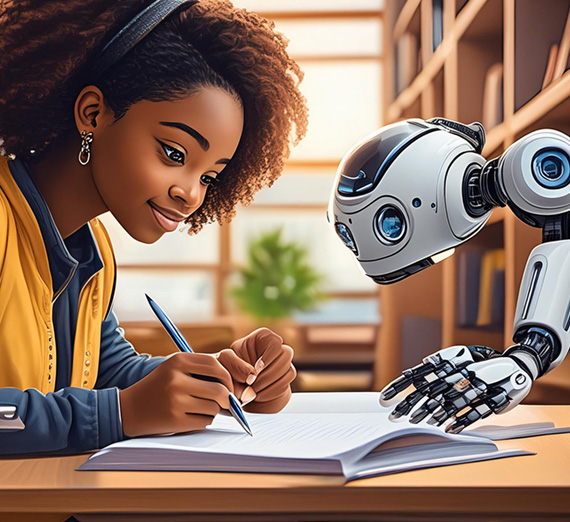Embracing Generative AI In the Classroom and Office

Generative AI (artificial intelligence) is rapidly transforming the world around us, and universities are uniquely positioned to be at the forefront of this exciting new frontier. But how can faculty, administrators, and staff members leverage generative AI to enhance their work and explore its creative potential?
I collaborated with several different chatbots to create this blog post outlining five engaging activities that can help you develop familiarity and proficiency with generative AI:
Train Your Own Pet AI
Services like my new favorite toy empower you to create custom image, sound, or pose recognition models. Imagine training a tool to identify specific objects in historical documents or classify musical pieces by genre for the music library. Teachable Machine offers a user-friendly interface with no coding required, making it a perfect platform for beginners looking to understand how AI works.
Unveiling Hidden Details in Historical Documents:
Are you a history buff sifting through mountains of historical documents? Train a Teachable Machine model to recognize specific objects or symbols within them. This can significantly reduce manual analysis time and unearth hidden patterns or trends. Imagine a model identifying specific types of ships in maritime trade records or recognizing architectural features in historical photographs.
Classifying Biological Specimens:
Working in the biology department? Train a model to differentiate between various plant or animal species based on images. This can expedite research tasks like specimen identification or image analysis for ecological studies.
Effortless Music Library Cataloging:
Managing a vast music library? Train a model to categorize music by genre based on sound samples. This can automate the cataloging process and free up staff time for other tasks. Imagine uploading samples of classical, jazz, and rock music to train a model that sorts incoming music files automatically.
Automated Equipment Monitoring:
Working in facilities management? Train a model to identify specific sounds associated with malfunctioning equipment. This can enable preventative maintenance by detecting potential issues before they escalate into major breakdowns. Imagine a model recognizing the whirring of a failing ventilation fan or the clanging of an overheating machine.
Developing Interactive Museum Exhibits:
Imagine museum exhibits where visitors can interact with AI models to learn more about artifacts. Train a model to identify specific objects displayed in an exhibit and trigger the delivery of relevant information or historical context.
These are just a few examples to spark your imagination. Teachable Machine offers a springboard for creating custom AI solutions that address specific needs and challenges within your university setting. As you experiment and explore, you'll gain a deeper understanding of AI's capabilities and its potential to revolutionize the way we work, teach, and learn. Here is a video explaining how to train an image recognition model:
AI as Your Muse
Struggling for inspiration? Generative AI tools can provide a springboard for fresh ideas. Platforms like , , , or can generate different creative text formats, from poems to code, based on your input. Or use AI-generated text as a starting point for brainstorming a new lecture topic, developing a research proposal, or crafting the opening line of a grant application.
Fresh Lecture Topics:
Feeling stuck in a rut with your lecture topics? Provide , , , or with keywords related to your course and let AI generate a range of potential topics. You might be surprised by unexpected angles or creative connections you haven't considered before. Imagine feeding keywords like "Renaissance Art" and receiving suggestions like "The Intersection of Science and Religion in Renaissance Masterpieces" or "The Hidden Symbolism in Everyday Objects of the Renaissance."
Interactive Activities Galore:
Struggling to create engaging activities for your students? Use , , , or to brainstorm interactive exercises, thought-provoking questions, or creative writing prompts related to your course material. Imagine prompting , , , or for "interactive activities related to the theory of evolution" and receiving suggestions like a role-playing simulation of the Great Leap Forward or a debate on the ethics of genetic engineering.
Fostering Student Creativity:
Incorporate , , , or into student assignments or projects. Let students use it to generate story ideas, brainstorm creative solutions to problems, or explore different writing styles. Remember to address Academic Integrity regarding AI use in your syllabus to avoid any misuse or confusion on the part of your students.
Crafting Compelling Introductions:
The opening line of your grant proposal can make or break your chances of securing funding. Use , , , or to generate different options for captivating introductions that clearly articulate the significance of your research. Imagine feeding , , , or keywords like "renewable energy solutions" and receiving compelling opening lines like "As our planet faces the challenge of climate change, the need for innovative renewable energy solutions has never been greater" or "Imagine a world powered by the sun, wind, and tides. This is the vision behind our cutting-edge research in ..."
Strengthening Your Research Questions:
Refine your research question with the help of , , , or . Provide a brief overview of your research area and let , , , or generate multiple variations of your question, exploring different angles and potential complexities. This can broaden your perspective and ensure your research addresses a truly impactful question. Imagine inputting "the impact of social media on mental health" and receiving refined questions like "Does social media usage lead to increased anxiety in adolescents?" or "How do different social media platforms influence body image perception in young adults?"
Overcoming Writer's Block:
Hitting a wall while writing a research paper or developing a new research project? Use , , , or to generate different creative text formats related to your topic. Explore potential research directions, brainstorm new hypotheses, or generate outlines to structure your writing. Imagine feeding , , , or keywords like "microplastics in the ocean" and receiving prompts for creative writing pieces from the perspective of a microplastic particle or a poem highlighting the ecological impact of microplastics.
Beyond Academic Uses
Generative AI tools like , , , or aren't limited to academic endeavors. They can also spark creativity in unexpected ways:
Engaging Marketing Materials:
Working in university communications? Use , , , or to brainstorm taglines, slogans, or creative content for upcoming events or marketing campaigns. Or use a tool like Copilot to generate market analysis for a new proposal.
By using generative AI tools like , , , or as a springboard for creativity, you can overcome writer's block, generate fresh ideas, and approach your work with a renewed sense of inspiration. Remember, AI is not meant to replace your own creativity; it's here to augment it, helping you reach new heights of innovation and excellence in your academic pursuits.
- Instructional Design and Delivery IDD




